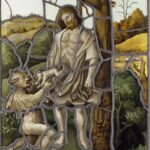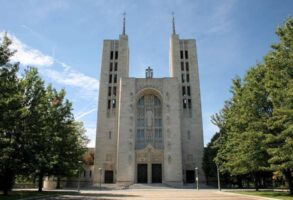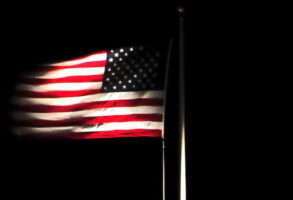Published October 7, 2019
George Weigel is Distinguished Senior Fellow of Washington’s Ethics and Public Policy Center, where he holds the William E. Simon Chair in Catholic Studies. He writes a weekly syndicated column and is the author of over twenty books, including Witness to Hope: The Biography of Pope John Paul II (1999), The End and the Beginning: Pope John Paul II—The Victory of Freedom, the Last Years, the Legacy (2010), and The Fragility of Order: Catholic Reflections on Turbulent Times (Ignatius Press, 2018).
His new book The Irony of Modern Catholic History: How the Church Rediscovered Itself and Challenged the Modern World to Reform. was recently published by Basic Books. He recently corresponded with CWR’s editor Carl E. Olson about his new book, which offers a detailed and often surprising examination of the complex and challenging relationship between Catholicism and modernity.
CWR: You begin by stating that this book is aimed at “refocusing”, or “renarrativizing” the way that most people understand the history of the Catholic Church over the past 250 years, especially the Church’s relationship with modernity. Why this need to refocus and reconsider? What do many histories miss or even misrepresent in how they present this history?
George Weigel: The Irony of Modern Catholic History is like an emblema, those framed mosaics, often telling a story from antiquity, that were popular decorations in the homes of the wealthy in classical Rome — and of which we find marvelous examples in the Basilica of St. Mary Major in Rome, telling the biblical story in colored stone.
What I’ve done in this book is re-arrange the stones crafted by distinguished historians in a new and wider frame, which I think brings the story of Catholicism and modernity into sharper focus. Previous “framings” of the story are unilinear: modernity acts, Catholicism reacts, end of story. But there has been much more going on, these past two hundred fifty years, than an action-reaction cycle. Through a complex interaction that began with each side hurling anathemas at the other — secular modernity condemning the Church as inimical to the modern aspiration to freedom, the popes of the mid-nineteenth century responding with their own rhetorical thunderbolts of condemnation — the Catholic Church rediscovered the truth about itself as an evangelical, missionary enterprise, and in doing that developed a social doctrine that just might help save the post-modern world from its own accelerating incoherence.
No one expected either of those developments around, say, 1878, when Pius IX died, so there are, indeed, many ironies in the fire of the Catholic encounter with modernity.
CWR: You provide a multi-faceted definition of “modernity”. What are some of the essential qualities of modernity? And why and how is pluralism a key part of modernity?
But from a Catholic point of view — or from the point of view of any Christians serious about the Great Commission of Matthew 28 — what “modernity” means is that religious conviction is no longer a taken-for-granted given, that religious traditions are no longer transmitted by the ambient public culture, and that the act of faith can only be the result of a personal encounter with the Lord Jesus Christ, which then leads the believer into the communion of believers we know as the Church. And that Church exists for mission, because if it doesn’t live its life as an evangelical mission the Church will wither away, as it’s done in so much of western Europe.
Under the social and cultural conditions of modernity (and now post-modernity), religious belief is a deliberate choice, not an ethnic or cultural inheritance.
CWR: In the opening chapter, you note that the relationship between Catholicism and modernity, especially for much of the nineteenth century, was bound up in how the papacy was exercised and understood. What was “problematic” about the papacy at that time?
Weigel: The problem in a nutshell was that the Bishop of Rome was also a temporal sovereign, the autocratic ruler of a good-sized chunk of the middle of Italy called the Papal States. And because the popes of the time tended to identify the Office of Peter with that temporal sovereignty, the papacy found itself deeply disconcerted by political modernity’s aspirations to freedom and self-governance. Curiously enough, the “world” tended to think of the papacy in the same way, such that, when Pius IX lost the last remnant of the Papal States in 1870, most of the great and good of Europe thought the papacy — and by extension, the Catholic Church — was finished as a significant actor on the world stage.
But that turned out to be exactly wrong, for the loss of the Papal States liberated the papacy to be the office of religious and oral witness it was always intended to be — a liberation that John Paul II, for example, turned to world-historical effect during his pivotal role in the collapse of European communism.
CWR: You argue that many of the problems and conflicts between the Church and modernity had roots in lacking or imbalanced ecclesiologies. What were some of the issues involved? Who were some of the key thinkers (who you call “explorers and pioneers”) who addressed those issues?
The path to that enriched ecclesial self-understanding was scouted in the nineteenth century by thinkers like Johann Adam Mohler, Matthias Scheeben, Antonio Rosmini, and John Henry Newman, whose work helped create the ecclesiological renaissance of the twentieth century.
CWR: Leo XIII was, you state, a far more “pivotal figure in the multi-act drama of Catholicism-and-modernity” than most understand or acknowledge. What are some examples of this? And how was Leo’s emphasis on Thomism and natural law so vital to his vision of the way forward?
Weigel: Gioacchino Vincenzo Pecci spent more than two decades in a kind of ecclesiastical exile, as Bishop of Perugia, and during those years he thought through the problem of Catholicism and modernity in depth. So when he became pope in 1878, this man who was elected as an elderly place-holder, a pope who wouldn’t last too long, took a bold, bold, grand-strategic decision: Leo XIII decided that, rather than just saying “No” to modernity, the Church would engage modernity, with distinctively Catholic tools, in order to convert modernity.
You can see that grand strategy displayed in Leo’s tomb in the Lateran basilica: he’s standing up, with his right foot thrust forward and his right hand extended, as if to say to the modern world, “We have something to talk about. We have a proposal to make.” And over the course of his twenty-five year papacy, he set in motion what I call in the book the “Leonine Revolution.” In the United States we know that dynamic primarily through Catholic social doctrine, to which Leo XIII first gave modern expression in the 1891 encyclical, Rerum Novarum. But Leo also created the modern Catholic study of the Church’s own history, even as he helped initiate modern Catholic biblical studies and a new approach to modern science.
During those Perugia years, Pecci formed a Thomistic Academy that he eventually brought to Rome when be became Leo XIII, for Leo was convinced that Thomas Aquinas — read in the original texts rather than filtered through centuries of commentators — offered the Church a unique set of conceptual tools for analyzing the social, cultural, intellectual, and political issues of modernity by analyzing those issues down to first principles: principles that we can know by reason, and which can therefore provide a kind of “grammar” for a conversation about the human future between believers and non-believers. Yet for all that he was a devout Thomist, Leo XIII also signaled an openness to fresh approaches to the understanding and presentation of ancient truths by making John Henry Newman, who was certainly no Thomist, a cardinal.
CWR: “Benedict XV is,” you write, “the most understudied and underappreciated popes of the twentieth century.” Why so? And what were some notable aspects of his papacy and thought, especially relating to modernity?
Benedict XV also made valiant, if fruitless, efforts to end the civilizational suicide of World War I and virtually bankrupted the Vatican by providing aid to refugees and prisoners of war. So with Benedict XV, the Church once again took up the Leonine task of engaging modernity in order to convert it. And it remained on that path throughout the rest of the twentieth century and beyond.
CWR: Pius XII, you note, is so commonly thought of in connection to World War II and controversies over the Jewish people that his important theological contributions are often overlooked. How did his work and thought set the stage for Vatican II?
Weigel: The most cited source in the footnotes to the documents of Vatican II is the Bible; the second most-cited source is the magisterium of Pius XII, because the first ten years of his pontificate were a time of real creativity in extending the Leonine Revolution. His 1943 encyclical, Mystici Corporis, pushed the Church further beyond the somewhat frozen concept of itself as a “perfect society” by presenting the Church as the Mystical Body of Christ, a sacramentally-ordered communion of faith within the world whose task is to help the world come to understand the truth about itself through the Gospel. Another 1943 encyclical, Divino Afflante Spiritu extended the Leonine Revolution in the Church’s reading of the Bible, as the 1947 encyclical Mediator Dei gave new impetus to the Liturgical Movement.
CWR: How would you summarize the basic qualities of the ressourcement theology, and why is that movement so important to the story of Catholicism and modernity? Were men such as de Lubac, Ratzinger, Bouyer, and von Balthasar “modernists” (or “crypto-modernists”) as is sometimes asserted? What was their basic approach to modernity?
Weigel: Ressourcement theology’s program was neatly captured in its name: “back to the sources” meant a renewal of theology through an intellectual encounter with the Bible, the Fathers of the Church, and the great medieval thinkers like Aquinas and Bonaventure.
This “retrieval” of the classic sources of Christian thought was essential at a moment when Catholic theology was in danger of becoming a subset of logic: theology understood as a string of syllogisms rather than as an encounter with the living Word of God and the great Christian minds of the past; theology informed by the sacramental life of grace as well as by human reason. At the same time, the ressourcement theologians you cited clearly understood that divine revelation is real and that divine revelation judges history (a conviction they wrote into Vatican II’s Dogmatic Constitution on Divine Revelation, Dei Verbum); and as the essence of “Modernism” is the notion that history judges revelation, these men were most certainly not “Modernists” or crypto-Modernists.
CWR: Vatican II, paralleling the larger debate over Catholicism and modernity, is often presented as a clash between modernizers and traditionalists. Why is this misleading? How better to understand the Council, its texts, and the aftermath?
Weigel: There was certainly a fault line between the anti-Leonine Revolution forces at Vatican II and those committed to Leo’s vision of engaging modernity in order to convert it, but the clash within the Council that continues to shape the Catholic debate today was not between traditionalists and reformers, but within the reformist camp itself. This break started to become visible during the Council’s third and fourth periods, in the fall months of 1964 and 1965, and what I call in the book the War of the Conciliar Succession has continued ever since.
What was the argument about? You can parse it many ways, but it really does come back, again, to the question of whether revelation judges history, or history (the “now”) judges revelation. In the first camp were those like de Lubac and Ratzinger (and Karol Wojtyla, Pope John Paul II) who insisted that the renewal and reform of the Church must be in continuity with revelation and the Church’s great tradition if it is to be authentic renewal; in the second camp were those who imagined (and still imagine) Vatican II as a rupture with the past or, as some now say, a “paradigm shift.”
As you look around the world Church today, I think you’ll find that those local churches that have taken the renewal-in-continuity-with-tradition approach are living, even thriving, while those who opted for Catholic Lite (as in much of the German-speaking Catholic world) are careening down the slippery slope to Catholic Zero.
CWR: You take on the claim, made by some progressives, that John Paul II had a “premodern” approach to theology and faith. Why is this claim made, and why does it miss the mark?
Weigel: That ridiculous charge was largely made by western European intellectuals and their American imitators who couldn’t imagine a “modern Polish intellectual.” And it completely misses the intellectual journey of a man who, on the basis of a solid foundation in Aristotle and Aquinas, used thoroughly modern philosophical methods to get at the perennial truth of thing and explain those truths to a post-Darwinian, post-Einsteinian, post-Freudian world.
CWR: A key theme of your book is religious freedom: its nature, roots, and centrality in the often tense and difficult relationship between Catholicism and modernity. What has been the trajectory, so to speak, of religious freedom over the past 250 years, and where do things stand today?
Weigel: In affirming religious freedom as a basic human right at Vatican II, the Catholic Church was retrieving and renewing an ancient tradition that traces its deepest roots to the Lord’s gospel injunction about Caesar and God: there are things of God’s that aren’t subject to Caesar’s remit, and if Caesar doesn’t understand that boundary and honor it, Caesar is inevitably going to become a tyrant.
The American experience of a constitutional democracy with no state Church, but which was nonetheless good for the growth of Catholicism certainly helped the process of retrieving that distinction between religious and political authority, as the development of ressourcement theology helped the Church to a richer understanding of the human person and the recovery of the ancient truth that the act of faith must be freely made it is is to be authentic. Experience and theory came together at Vatican II to produce Dignitatis Humanae, the Declaration on Religious Freedom. As for today, it’s obvious that religious freedom is threatened around the world, and not just in tyrannical states like China and Saudi Arabia; religious freedom is under threat in developed democracies in thrall to the ever-broadening demands of the sexual revolution, which is quite willing to sacrifice religious freedom (and freedom of speech, and other basic human rights) to its agenda.
CWR: Is it correct to say that one of your main arguments is that the (as you put in conclusion) “noblest aims and moral commitments of the modern project” can only be purified, realized, and accomplished through the Catholic Faith? If so, what are some ways in which that can be accomplished?
Weigel: It might be better to say that the noblest aims and moral commitments of the modern project can only be realized when those aims and commitments are grounded in the truths built into the world and us. Catholics know those truths by by faith and reason. Those who have not been given the gift of faith can still “get” to those truths by reason, and the Church ought to accompany genuine truth-seekers on that journey.
What both faith and reason teach us, however, is that the modern project is in deep trouble if it reduces the human person to a twitching bundle of desires, the satisfaction of which sums up “human rights.” That is not just a dumbed-down, debased concept of who we are and what we aspire to be; it’s a prescription for what Joseph Ratzinger rightly described in 2005 as a “dictatorship of relativism.”
George Weigel is Distinguished Senior Fellow of the Ethics and Public Policy Center, where he holds EPPC’s William E. Simon Chair in Catholic Studies. Carl E. Olson is editor of Catholic World Report and Ignatius Insight.










